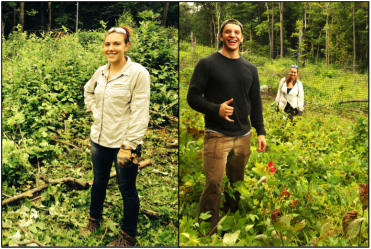The unseen drivers of forest regeneration:
herbaceous understory resilience to disturbance
 Vegetation removal team, summer 2015. From left to right: Michelle Spicer, Kyle Suess, Laíssa Leonis do Canto.
Vegetation removal team, summer 2015. From left to right: Michelle Spicer, Kyle Suess, Laíssa Leonis do Canto.
In the past few decades, eastern deciduous forests have experienced dramatic declines in herbaceous biodiversity of up to 90%, as well as large-scale shifts in dominant tree species from oaks to maples. In collaboration with the Carnegie Museum of Natural History at Powdermill Nature Reserve (Rector, PA), I am investigating how natural and anthropogenic disturbances interact to change plant community dynamics. Specifically, I am experimentally testing how deer herbivory, a dense recalcitrant understory layer, and salvage logging simultaneously impact forest regeneration after a large-scale (~30 acres) tornado blowdown. Three prevailing forest succession models underlie this experiment, and will be tested in the upcoming few years:
Shade tolerance model: The regenerating plant community will be dominated by fast-growing, shade-intolerant pioneer species post-disturbance (such as tulip poplar); salvage logging will further enhance dominance by increasing disturbance severity.
Priority effects model: Over time, existing understory species will dominate disturbed sites and then shift towards more long-living species; post-vegetation removal, the “successional clock” will be re-set, and species extant in the seedbank will dominate the regenerating forest.
Mammalian browse model: Browse-resilient species such as American beech will dominate disturbed sites even after logging and vegetation removal, as recent evidence suggests the legacy of overbrowsing lasts decades.
As a side project nested within these experiments, I am also studying tip-up mounds as putative refugia for deer browsing, and how salvage logging modifies plant community composition after natural disturbances.
Project publications:
Slyder JB, Wenzel J, Royo AA, Spicer ME, & Carson WP. “Post-windthrow salvage logging increases seedling and understory diversity with little impact on composition immediately after logging.” 2019. New Forests: 1-12.
Spicer ME, *Suess KF, Wenzel JW, & Carson WP. “Does salvage logging erase a key physical legacy of a tornado blowdown? A case study of tree-tip-up mounds.” 2018. Canadian Journal of Forest Research: 48, 976-982.
Shade tolerance model: The regenerating plant community will be dominated by fast-growing, shade-intolerant pioneer species post-disturbance (such as tulip poplar); salvage logging will further enhance dominance by increasing disturbance severity.
Priority effects model: Over time, existing understory species will dominate disturbed sites and then shift towards more long-living species; post-vegetation removal, the “successional clock” will be re-set, and species extant in the seedbank will dominate the regenerating forest.
Mammalian browse model: Browse-resilient species such as American beech will dominate disturbed sites even after logging and vegetation removal, as recent evidence suggests the legacy of overbrowsing lasts decades.
As a side project nested within these experiments, I am also studying tip-up mounds as putative refugia for deer browsing, and how salvage logging modifies plant community composition after natural disturbances.
Project publications:
Slyder JB, Wenzel J, Royo AA, Spicer ME, & Carson WP. “Post-windthrow salvage logging increases seedling and understory diversity with little impact on composition immediately after logging.” 2019. New Forests: 1-12.
Spicer ME, *Suess KF, Wenzel JW, & Carson WP. “Does salvage logging erase a key physical legacy of a tornado blowdown? A case study of tree-tip-up mounds.” 2018. Canadian Journal of Forest Research: 48, 976-982.
